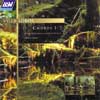Villa-Lobos Choros , Vol 1
A superb introduction to the imaginative and colourful music of Villa-Lobos
View record and artist detailsRecord and Artist Details
Composer or Director: Heitor Villa-Lobos
Genre:
Orchestral
Label: ASV
Magazine Review Date: 2/2004
Media Format: CD or Download
Media Runtime: 70
Mastering:
Stereo
DDD
Catalogue Number: CDDCA1150

Tracks:
| Composition | Artist Credit |
|---|---|
| Introduction to the Chôros |
Heitor Villa-Lobos, Composer
Adrian Leaper, Conductor Carlos Oramas, Guitar Gran Canaria Philharmonic Orchestra Heitor Villa-Lobos, Composer |
| Chôros No. 1 |
Heitor Villa-Lobos, Composer
Carlos Oramas, Guitar Heitor Villa-Lobos, Composer |
| Chôros No. 2 |
Heitor Villa-Lobos, Composer
Adrian Leaper, Conductor Gran Canaria Philharmonic Orchestra Heitor Villa-Lobos, Composer Johanne-Valérie Gélinas, Flute Radovan Cavallin, Clarinet |
| Chôros No. 3, 'Picapau' |
Heitor Villa-Lobos, Composer
Adrian Leaper, Conductor Gran Canaria Philharmonic Chorus Gran Canaria Philharmonic Orchestra Heitor Villa-Lobos, Composer |
| Chôros No. 4 |
Heitor Villa-Lobos, Composer
Adrian Leaper, Conductor Gran Canaria Philharmonic Orchestra Heitor Villa-Lobos, Composer |
| Chôros No. 5, 'Alma brasileira' |
Heitor Villa-Lobos, Composer
Heitor Villa-Lobos, Composer Sergio Alonso, Piano |
| Chôros No. 6 |
Heitor Villa-Lobos, Composer
Adrian Leaper, Conductor Gran Canaria Philharmonic Orchestra Heitor Villa-Lobos, Composer |
| Chôros No. 7, 'Settiminio' |
Heitor Villa-Lobos, Composer
Adrian Leaper, Conductor Gran Canaria Philharmonic Orchestra Heitor Villa-Lobos, Composer |
Author: John Duarte
The word ‘Chôro’ derives from the verb chôrar (to weep), a reflection of the vein of melancholy never far below the surface of even the more cheerful of Brazilian popular music – a dichotomy in the national character, inherited via the Portuguese fado. The 14 Chôros of Villa-Lobos are remarkable fusions of the multi-faceted music of Brazil with that of Europe, written in the 1920s, long before the induction of American popular music gave birth to bossa nova.
After completing the cycle in 1929, Villa-Lobos added a trailer-like ‘Introduction’ in which he refers to themes that have yet to be heard in the various Chôros. To an orchestra of epic size and variety he adds a guitar, the instrument to which the first Chôro is entrusted; its thematic material, however, is not that of the Chôro, rather is it related to the opening of his then-unwritten Guitar Concerto.
No two works call for the same instrumentation. No 2 is a dance-rhythmic flute/clarinet duet. No 3, for male chorus and wind, is based on an Indian song, Villa-Lobos’ earliest depiction of rainforest Brazil. No 4, for three horns and trombone, is portentous, contrapuntal and amusing by turns. No 5, subtitled Alma brasileira (‘Brazil’s soul’) encapsulates the melancholy/cheerful dichotomy. No 6, for full orchestra, returns to the landscape of Brazil, a kaleidoscopic ‘tour’ of its vast size and variety. There is nothing specifically Brazilian about No 7 (for eight-part chamber ensemble) save some fleeting dance rhythms and its unmistakable character, but it is essentially cheerful with a romantic core.
No other corpus of his works offers greater access to the imaginative and colourful world of Villa-Lobos, and the catalogue lists no currently available of the Chôros in their entirety. The remaining seven are scheduled to follow on a second disc. These splendid performances do full justice to every piece and are as well recorded as might be hoped for. They are both listener-friendly and unique in the 20th-century world of music and I cannot too strongly recommend you to come to know them through this recording.
After completing the cycle in 1929, Villa-Lobos added a trailer-like ‘Introduction’ in which he refers to themes that have yet to be heard in the various Chôros. To an orchestra of epic size and variety he adds a guitar, the instrument to which the first Chôro is entrusted; its thematic material, however, is not that of the Chôro, rather is it related to the opening of his then-unwritten Guitar Concerto.
No two works call for the same instrumentation. No 2 is a dance-rhythmic flute/clarinet duet. No 3, for male chorus and wind, is based on an Indian song, Villa-Lobos’ earliest depiction of rainforest Brazil. No 4, for three horns and trombone, is portentous, contrapuntal and amusing by turns. No 5, subtitled Alma brasileira (‘Brazil’s soul’) encapsulates the melancholy/cheerful dichotomy. No 6, for full orchestra, returns to the landscape of Brazil, a kaleidoscopic ‘tour’ of its vast size and variety. There is nothing specifically Brazilian about No 7 (for eight-part chamber ensemble) save some fleeting dance rhythms and its unmistakable character, but it is essentially cheerful with a romantic core.
No other corpus of his works offers greater access to the imaginative and colourful world of Villa-Lobos, and the catalogue lists no currently available of the Chôros in their entirety. The remaining seven are scheduled to follow on a second disc. These splendid performances do full justice to every piece and are as well recorded as might be hoped for. They are both listener-friendly and unique in the 20th-century world of music and I cannot too strongly recommend you to come to know them through this recording.
Discover the world's largest classical music catalogue with Presto Music.

Gramophone Digital Club
- Digital Edition
- Digital Archive
- Reviews Database
- Full website access
From £8.75 / month
Subscribe
Gramophone Full Club
- Print Edition
- Digital Edition
- Digital Archive
- Reviews Database
- Full website access
From £11.00 / month
Subscribe
If you are a library, university or other organisation that would be interested in an institutional subscription to Gramophone please click here for further information.




